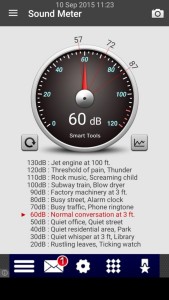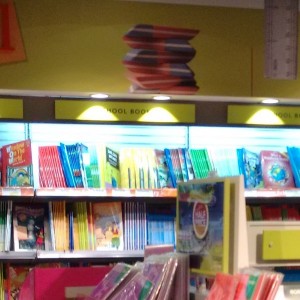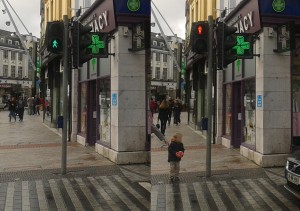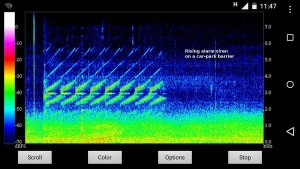Public spaces challenge everyone to sensory experiences that they have little control over, other than leaving or changing the time and places you visit. Sensory experiences include the obvious external 5 senses, sight, sound, smell, taste and touch. They also include the internal senses, vestibular (balance, challenged on escalators and lifts), proprioceptive (body location, challenged in unfamilar small spaces) and temperature (challenged when you have no control over temperature, but only one set of clothes).
Public spaces are often retail spaces, and intend to excite the senses, promote urgency, lower inhibitions to spend and generally increase profit by speeding footfall. Some of the methods used (loud noise, bright flashing lights, jumbled goods and continuously changing shop layouts) may seem especially perverse to anyone who seeks calm and order. They also work against the systematic shopper attempting to follow a structured shopping list.
I leave shops without buying anything on about 1/5 of all the times I got out to buy something, because the noise or odours are too strong, or the shop ‘feels’ emotionally-charged, or (worst of all!) because the product has moved. Shops frequently move products around, because it apparently increases shopper attention and leads to greater sales. Not for me, I like predictable order.
It would be interesting to be able to visualise the exposure to smell, taste and touch, but I have not found a simple method – there are some lovely sensory maps of public spaces in the exhibition Sensory Maps by Kate McLean. I find odours almost overpowering in confined spaces like the cinema or in buses just after rain, when wet coats give off the smell of every meal and every pet that every fellow-traveller has been in recent contact with. Imagine if your phone could detect the perfumes, cleaning compounds, body odours and cooked food aromas in a space and display a map, something like the WiFi points displayed below:

Visualizing WiFi: All the available access points and activated personal zones in a large retail space. Hello Rosie, whoever you are! I have used photographs and two simple applications to record images of the frequency distribution and overall volume of sound.
Sound level
As I am writing this I have the radio on playing jazz music and I can hear my computer fan, traffic and some distant roadworks. The sound level, recorded by a mobile phone app called Sound Meter, is between 30 and 40 decibels (dB), rated as “Quiet whisper, library” up to “Quiet residential area, park”.

A quiet office and normal conversation are rated at 50-60 dB. These are comfortable overall loudness levels but (as shown below) some sounds can be very irritating or distracting, at any loudness.

Some public spaces have loud music, often 90-100 dB in public areas (this is a footpath some distance from a music venue) and often much louder inside. This is uncomfortably loud, especially if the music is not your own taste.
Cognitive issues
The layout of shops can challenge balance (e.g. fast or jerky escalators) and proprioception (squeezing through narrow aisles and tight doorways), with shop signs that defy logic. The layout and signs are important for people who don’t or can’t ask for directions. These designs are probably trendy or stylish, but hard to read:

These shop signs run all the text together (“1Menswear” and “0Ladieswear” is not the score in a profanity match), and includes a mysterious “1TRF”.

These badly-lit signs have a tiny cone lit by spot lamps, the remaining text in shadow. They also (if you do read them) have not been moved when all the product was moved, so they are incorrect anyway. Signs are really important for orientation, especially for people with limited social interaction skills.

This pharmacy sign is animated – it switches on and off and has a flashing phase, just like the pedestrian crossing sign. People step in front of the traffic when the green cross lights up, without realising why they thought it was safe to cross.

This happens to be the RTÉ 9 News, but most broadcast radio and TV news add excitement and buzz to the news, either in the headlines (as with RTÉ) or throughout the entire bulletin. This image shows the first few seconds of drum and cymbal noises, an orchestral swell and then the voice saying “On the news tonight …”. You can listen to the introduction here: RTE Nine News. Speech appears in a frequency band of around 300 Hz to 3400 Hz, with the lower part important in discriminating between sounds like “M” and “B” – exactly where the drums are playing. The higher frequencies are important in discriminating between “S” and “T” sounds, where the snares and cymbals are playing. The percussion and music continues throughout the entire headline section on RTÉ and throughout the entire news bulletin on other stations.
Visual distraction
Visual excitement – tinsel floating in the breeze from a fan, flashing lights, moving shop displays and plenty of moving customers (in mirrors and through windows) – increase the sense of buzz and energy. This may be good for sales, but probably makes all shoppers grumpy and exhausted, especially people close to sensory meltdown.

These shop spotlights are low down, in the same eyeline as the product, and not supplemented by even lighting. It is hard to see. The ceiling is painted dark grey (it was white, providing calm, even lighting, before a refit). Apparently the black ceiling and spotlit faces assist the focus and clarity of the many CCTV cameras in the shop.

This in-your-face book display (now replaced with a more gentle look) used spotlights, neon wording and brightly-lit book piles. The shelves of books seemed almost an irrelevance. The walls curve, so there are no quiet corners to take a breath of sensory overload is approaching. This shop, like many, also sells chilled drinks and chocolates from a standing display with a loud refrigerator compressor.

These path lights are completely useless at lighting the path – they show the boundaries, but not the surface, or any litter (such as glass or dog-mess). The uplighters set into the path also shine up the legs of people queueing for the ATM, which looks very strange.
Sound distraction
Sound does not need to be loud to be upsetting, irritating or distracting. Unwanted sound (somebody else’s taste in music), unpredictable sounds and sounds that have intense structure are all irritating. This may translate to buzz or excitement, which may translate to increased spending, which is why shops and cafés use glass and plastic surfaces to reflect customer noise and plenty of piped sound (including recorded customer noise).
Some shopping centres move the music tempo and overall sound levels up towards lunch and closing time, to increase customer urgency. Some even collect sound through microphones and play it back through loudspeakers to increase the sense that a space is busy.

Sudden and unpredictable noises can be literally shocking if they are unexpected. These peaks are cups being stacked in a café.

The continuous horizontal line here is a 5 kilohertz (kHz) scream from the lighting system in a shop (that is D# in the eight octave, the one just after the highest key on a piano). Some people notice this and are unable to stop noticing it.

This is the repeated rising siren tone from a carpark barrier that is about to drop – it is intended to be very noticeable.

These sudden impact noises are from randomly-spaced cars driving over a loose inspection cover. The noise is less annoying when the traffic is very busy and evenly-spaced cars are driving more slowly. The very structured, intense tones towards the right are a car horn and all its over-tones.

This regular series of beeps at about 3.1 kHz (G7, at the top of the piano) is a pure-tone reversing alarm. It is followed by an intense brake squeal before the vehicle continues reversing.

This is a very fatiguing noise that is neither ringing nor purely random, created by an angle grinder disk cutting concrete. The disk rings and the concrete does not, so there are some recognizeable tones (the horizontal lines), but within a broad spectrum of intense noise. The grinder starts and stops unpredictably, sometimes running for a very long time, sometimes quiet for a long time.


The pneumatic road drill creates bursts of closely-spaced broad spectrum sound energy, literally little explosions of sound from the air compressor and the impacted road surface. The sequences of percussions start and stop unpredictably. The sudden bang about 1/3 of the way from the left is the metal bucket hitting the tarmac.

Intensely-focused noise is irritating, sometimes intentionally. This beeping at about 2.3 kHz (D7) and its octave overtone at about 4.7 kHz is a broken payphone – it has been broken for more than a year, and has beeped at the entrance to a shopping centre continuously since it was broken. The phone company does not respond.

This comparatively gentle signal is a complex warbling tone (not a pure tone) from a pedestrian crossing button. These complex warbles are very easy to locate in space. It emits short beeps far apart on the red phase and rapid, pure-tone beeps at about 1 kHz (B5) on the crossing phase.

All of the air conditioning plant for an entire retail space are located in a platform in front of one single office. The compressors are thermostatically controlled, so they switch on and off at irregular intervals. The thump as they all switch on is like being kicked in the chest.
Value images
These images are intended to shock and raise awareness of the dangers of drink driving. They also stigmatize people who are enabled by prosthetic limbs or wheelchairs, and stigmatize enabling technologies in general. They pass a value judgement on human lives, that some are worth less than others.

The Crashed Lives poster series displays prosthetic limbs, wheelchairs and occupational therapy equipment – the display location is the outdoor ashtray on pubs, following the indoor smoking ban. People who use these enabling devices and therapies do not have “crashed lives” that are worth less than “intact” lives.

This ashtray is simply bizarre – it is down a step and at a height of 5’4″ from the pavement – that means about a half of all women and a quarter of all men can not look down into the receptacle holes, to see where to drop their cigarette butt. If you were cool enough to go drinking and smoking with a movement impairment, this will challenge. I have been told that “people with disabilities should not smoke anyway”, but that simply reinforces the negative message of this public venue.
Brilliant use of photographs and links to building codes in this photoblog on “Tap Operating Instructions”, for the kind of tap that needs instructions! – http://www.withernay.com/news/1182015tap-operating-instructions
Amazing work! I am looking forward to learning more about your take on sensory issues and space.
I like the idea of an “Unhearing Aid” or “World Filter” that would take the real world soundscape, filter it, take out the loud or unpleasant bits, and feed the useful parts into noise-cancelling or isolating headphones. I wrote about this also at Restored Hearing, a company that has a sound protection technology to reduce harmful environmental noise.
You can read my guest post here: Autism, hypersensitivity to noise and sensory processing – https://restoredhearing.com/2015/11/20/autism-hypersensitivity-to-noise-and-sensory-processing/
Anyone interested in writing a mobile phone app or modifying a hearing aid is welcome to ask for any ideas.